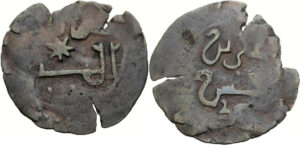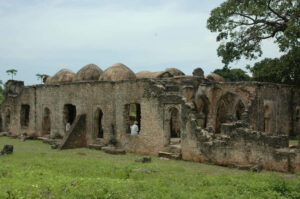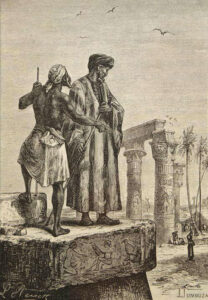
Not all coins are eye-catching, high value and composed of precious metal. Yet some of the small, nondescript coins which you might easily pass over when looking at a larger collection can nevertheless reveal fascinating stories- they can introduce you to new cites and cultures which you never knew existed. Obviously these “unknown” areas of numismatics vary from person to person. Coming from a background in ancient coins, I knew little about coinage with Arabic legends. A few weeks ago, however, the following coin landed on my desk as part of a collection. Small, 22 mm, damaged, copper, with a bit of (for me) unintelligible legend. As a professional numismatist I couldn’t just say, “Oh, that doesn’t fall within my interest area, I’ll ignore that” – I had to find out what it was. Luckily the collector had left a little slip of paper with the name, “Kilwa Kisiwani” on it, so I did what most people in the 21st Century would do and googled it.

My search led me to Kilwa District in the Lindi region of today’s Tanzania in Africa. There, on the largest of five islands on the coast, a Swahili “City State” developed in the Middle Ages, under a king-like ruler. Swahili civilization arose through the cultural contact of East African peoples (mainly Bantu) with Arabic traders following the arrival of Islam in the region in the 9th Century A.D., though the name, “Swahili”, was not used until later. In Kilwa the earliest mosque in Africa was constructed from the 11th-13th centuries. The Shirazi Dynasty was founded in Kilwa by Ali ibn Hasan, who left Persia with his six sons and travelled to East Africa because he had had a dream that his country was about to fall. This is variously dated as taking place in the 10th-12th centuries. A hoard of coins found at Mtambe Mkuu suggests that the Shirazi dynasty was already present in the 11th century. The dynasts took over the gold trade from Sofala (Mozambique) and became rich by charging customs duties on visiting merchants. Salt, ivory, ebony, spices, aromatic gums, coconut oil, tortoiseshell and of course gold were exported from the African interior, while Chinese and Arabic imports included silk and porcelain. Testament to this trade are also a few copper coins. Through the trade routes, the coins of Kilwa travelled widely within Africa- two coins of Kilwa were found in the ruins of great Zimbabwe.

This coin was struck under Sultan Sulaiman ibn Hasan in ca. 1331 A.D. (732 al Highra). There is no indication of a mint or a date, but the legend reads Sulaiman ibn al-Hasan yathiku in three lines in Arabic / bi Maula’l-Minan in two lines of Arabic.

In the 13th and 14th centuries, Kilwa was one of the wealthiest Swahili city states, thanks to these extensive trade links with Africa and Arabia. Its inhabitants were able to construct impressive stone and wood buildings. Despite extensive links with the Arab world, many scholars still stress the African nature of Kilwa and its culture. In 1330 the great Arab traveller Ibn Battuta visited the city as part of his travels through Bilad-al-Zanj (“Country of the Blacks”), as the Arabs called the Swahili coast in East Africa. He described Kilwa as „one of the finest and most beautifully built towns; all the buildings are of wood, and the houses are roofed with dis weeds (a type of Mediterranean grass)“. This was practically the same time that our coin was struck under Sultan Sulaiman ibn Hasan in ca. 1331 A.D. (732 al Highra). The Husuni Kubwa Palace in Songo Mnara, also dating from 1310-1333 A.D., still exists as substantial ruin. It was part of a complex political structure which included the sultan and his family, an emir (military leader), a wazir (prime minister), muhtasib (police chief), and many resident governors, tax collectors and other minor officials. Like other buildings on the site, the palace was built using lime mortar mixed with the local coral. It was excavated by Neville Chittick in 1962.

The civilization of the Swahili coast consisted of flourishing trade centres for several centuries, but it never grew into a unified empire. Kilwa itself was destroyed in July 1505 A.D., when the Portuguese burned and looted the city. It declined after that, although the settlement never completely disappeared. The ruins of the earlier buildings still remain, however, and along with Songa Mnara and five other sites in Tanzania are classified as UNESCO World Heritage (1980). Modern archaeological work began at Kilwa in 1955 when Dr. James Kirkman excavated a trench alongside a sea-wall on the site during a visit to the site by Sir Mortimer Wheeler and Fr. Gervase Mathew, and continued into the 1960s. The excavations in Kilwa Kisiwani have revealed many indications of the widespread trade links, including Chinese and Islamic pottery.
This coin, along with many other fascinating coins from the Arabic world and elsewhere, forms part of the Electronic Auction 3 to be held by Münzen & Medaillen GmbH on October 9th, 2022 through Biddr.
Here you can read a comprehensive auction preview.
The Silk Road is known for cultural exchange. Roman coins probably reached Japan via this route.


